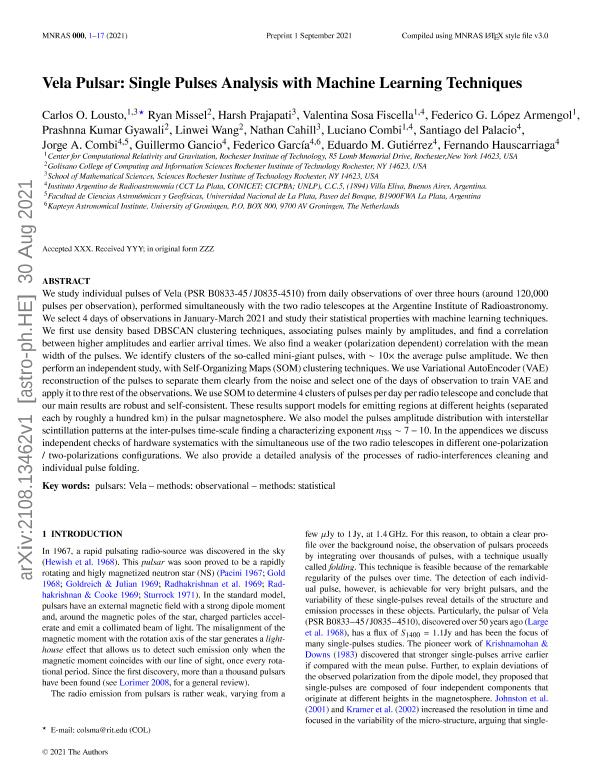Artículo
Vela pulsar: Single pulses analysis with machine learning techniques
Lousto, Carlos Oscar ; Missel, Ryan; Prajapati, Harshkumar; Sosa Fiscella, Sofía Valentina
; Missel, Ryan; Prajapati, Harshkumar; Sosa Fiscella, Sofía Valentina ; Lopez Armengol, Federico Gaston
; Lopez Armengol, Federico Gaston ; Gyawali, Prashnna Kumar; Wang, Linwei; Cahill, Nathan D.; Combi, Luciano
; Gyawali, Prashnna Kumar; Wang, Linwei; Cahill, Nathan D.; Combi, Luciano ; del Palacio, Santiago
; del Palacio, Santiago ; Combi, Jorge Ariel
; Combi, Jorge Ariel ; Gancio Gonzalez, Guillermo Matias
; Gancio Gonzalez, Guillermo Matias ; García, Federico
; García, Federico ; Gutiérrez, Eduardo Mario
; Gutiérrez, Eduardo Mario ; Hauscarriaga, Fernando Pablo
; Hauscarriaga, Fernando Pablo
 ; Missel, Ryan; Prajapati, Harshkumar; Sosa Fiscella, Sofía Valentina
; Missel, Ryan; Prajapati, Harshkumar; Sosa Fiscella, Sofía Valentina ; Lopez Armengol, Federico Gaston
; Lopez Armengol, Federico Gaston ; Gyawali, Prashnna Kumar; Wang, Linwei; Cahill, Nathan D.; Combi, Luciano
; Gyawali, Prashnna Kumar; Wang, Linwei; Cahill, Nathan D.; Combi, Luciano ; del Palacio, Santiago
; del Palacio, Santiago ; Combi, Jorge Ariel
; Combi, Jorge Ariel ; Gancio Gonzalez, Guillermo Matias
; Gancio Gonzalez, Guillermo Matias ; García, Federico
; García, Federico ; Gutiérrez, Eduardo Mario
; Gutiérrez, Eduardo Mario ; Hauscarriaga, Fernando Pablo
; Hauscarriaga, Fernando Pablo
Fecha de publicación:
02/2022
Editorial:
Wiley Blackwell Publishing, Inc
Revista:
Monthly Notices of the Royal Astronomical Society
ISSN:
0035-8711
Idioma:
Inglés
Tipo de recurso:
Artículo publicado
Clasificación temática:
Resumen
We study individual pulses of Vela (PSR B0833−45/J0835−4510) from daily observations of over 3 h (around 120 000 pulses per observation), performed simultaneously with the two radio telescopes at the Argentine Institute of Radioastronomy. We select four days of observations in 2021 January to March and study their statistical properties with machine learning techniques. We first use Density-Based Spatial Clustering of Applications with Noise clustering techniques, associating pulses mainly by amplitudes, and find a correlation between higher amplitudes and earlier arrival times. We also find a weaker (polarization dependent) correlation with the mean width of the pulses. We identify clusters of the so-called mini-giant pulses, with ∼10 times the average pulse amplitude. We then perform an independent study, with Self-Organizing Maps (SOM) clustering techniques. We use Variational AutoEncoder (VAE) reconstruction of the pulses to separate them clearly from the noise and select one of the days of observation to train VAE and apply it to the rest of the observations. We use SOM to determine four clusters of pulses per day per radio telescope and conclude that our main results are robust and self-consistent. These results support models for emitting regions at different heights (separated each by roughly a hundred km) in the pulsar magnetosphere. We also model the pulses amplitude distribution with interstellar scintillation patterns at the inter-pulses time-scale finding a characterizing exponent nISS ∼ 7–10. In the appendices, we discuss independent checks of hardware systematics with the simultaneous use of the two radio telescopes in different one-polarization/two-polarizations configurations. We also provide a detailed analysis of the processes of radio-interferences cleaning and individual pulse folding.
Palabras clave:
METHODS: OBSERVATIONAL
,
METHODS: STATISTICAL
,
PULSARS: INDIVIDUAL: VELA
Archivos asociados
Licencia
Identificadores
Colecciones
Articulos(IAR)
Articulos de INST.ARG.DE RADIOASTRONOMIA (I)
Articulos de INST.ARG.DE RADIOASTRONOMIA (I)
Citación
Lousto, Carlos Oscar; Missel, Ryan; Prajapati, Harshkumar; Sosa Fiscella, Sofía Valentina; Lopez Armengol, Federico Gaston; et al.; Vela pulsar: Single pulses analysis with machine learning techniques; Wiley Blackwell Publishing, Inc; Monthly Notices of the Royal Astronomical Society; 509; 4; 2-2022; 5790-5808
Compartir
Altmétricas



